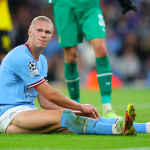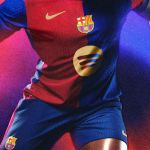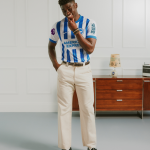
The significance of Haaland's signing with Nike
Can the City striker's sponsorship revitalise an otherwise down market?

March 7th, 2023
Football boots are a necessary, fundamental element of the game. A condition you cannot escape if you want to be injury-free on the pitch, and they represent the material seat of the wearer's talent. It is therefore no coincidence that they have taken on a symbolic role over the decades, associated with the luck and victories of the players who laced them up before a big game. Without bothering the giants of the sport, every player has a reference shoe that becomes the easiest way to approach the performance of their favourite players in the eyes of the consumer and the athlete. And this symbiotic relationship between football shoe and superstar, which runs like a thread through the history of football, has been instrumental in creating one of the most thriving sports markets. Even today, football boot sales are one of the highest values when it comes to technical equipment, a value that is not surprising given the very high number of players in The Beautiful Game worldwide.
The big manufacturers have therefore always competed for the biggest champions with multi-million dollar contracts, knowing full well that the game was worth the usual candle. After all, who would not have liked to wear the same shoes as Pelé or dribble like Maradona? The investment always led to resounding success. And even in recent days, as brands have courted the signature of Erling Haaland, that kind of enthusiasm has not gone away, with Nike seemingly willing to spend around £20 million a year to secure arguably the most prolific striker of his generation. Figures that take us back to bygone days when champions shared their technical sponsors and battled for glory in epic commercials. Or even earlier, when PUMA paid Pelé to lace up his shoes in Mexico 1970.
Today, the shoes sell but do not conquer, and the many models that have updated the aesthetics and functionality of the historic silhouettes are still worn by footballers around the world. Some of them, however, shun the latest innovations and opt for older models, such as Tony Kross, who never parted with his adidas 11Pro, while Vinicius Jr. even painted his own playing shoes black in his personal war against Nike. This shows us the many limitations of today's sponsorships, which are not as prevalent in the minds of fans as they used to be and play more of a commercial role. So in this context, the signing of Haaland is a breath of fresh air for a market that was slowly drying up.
Most importantly, it marks the strong comeback of Nike, which had neglected the acquisition of new talent in recent years to devote itself instead to storytelling and communities, with a not inconsiderable financial commitment to secure one of the most prolific strikers of his generation. After losing first Neymar and then Grealish to PUMA a few days ago, Nike has suffered a major blow that shows what could be the Beaverton-based brand's new line, taking the big players at any cost and letting the other talents go. The £20 million Nike has reportedly promised Haaland exceeds even what the US brand is currently paying its other young superstar in the squad, Kylian Mbappé. The two will be tasked with taking the Swoosh into the near future, when international football, and therefore brands, will no longer thrive on Messi-Ronaldo dualism.












